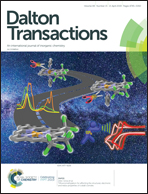[9]aneN3-based fluorescent receptors for metal ion sensing, featuring urea and amide functional groups†
Abstract
We describe here the synthesis and coordination properties of three new derivatives of [9]aneN3 containing phenyl/quinoline pendant arm derivatives (L1, L2 and L3, respectively) also featuring urea (L1–L2) or amide (L3) functions as “non-innocent” spacers. At first, L1, L2 and L3 were studied considering the interaction with a series of anions (AcO−, BzO−, H2PO4−, F−, and Cl−) by means of 1H NMR measurements. Subsequently, the optical responses of L2 and L3 in the presence of several metal ions Cd2+, Co2+, Cu2+, Fe3+, Hg2+, K+, Mg2+, Mn2+, Ni2+, Zn2+ and Pb2 were analysed in MeCN/H2O (4 : 1 v/v). As observed by spectrophotometric and spectrofluorimetric titrations, there were significant changes in the absorbance and fluorescent emission of L2 upon addition of increasing amounts of Cd2+, Zn2+, Pb2+ and Cu2+ in MeCN/H2O (4 : 1 v/v). In particular, titrations of L2 with Cd2+, Zn2+ or Pb2+ showed an almost comparable CHEF effect up to an M2+/L2 molar ratio of 1. Overall, no significant optical selectivity was observed in the case of L2. Conversely, L3 revealed an OFF–ON selective response only in the presence of the Zn2+ ion in MeCN/H2O (4 : 1 v/v), which can be attributed to the formation of both 1 : 1 and 1 : 2 metal-to-ligand complexes, as also confirmed by potentiometric measurements. Finally, crystals of [ZnL1(Ac)](Ac) (1), [CuL1(Cl)](Cl)·H2O (2) and [CuL3](NO3) (3) were grown and analysed by X-ray diffraction. 1 and 3 feature the metal center in a pseudo-octahedral coordination geometry coordinated also by the carbonyl group from one pendant arm, while in the case of 2, one of the six coordination sites in the final distorted octahedral geometry is occupied by the nitrogen donor from the urea group of one pendant arm.
![Graphical abstract: [9]aneN3-based fluorescent receptors for metal ion sensing, featuring urea and amide functional groups](/en/Image/Get?imageInfo.ImageType=GA&imageInfo.ImageIdentifier.ManuscriptID=C9DT00288J&imageInfo.ImageIdentifier.Year=2019)


 Please wait while we load your content...
Please wait while we load your content...